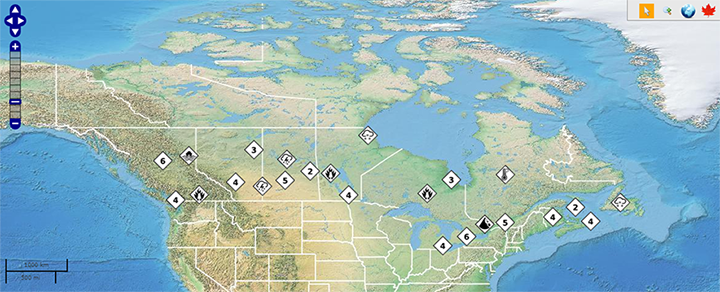Hail
Hail forms in the core of a thunderstorm. Water vapour in warm, rapidly-rising air masses (convection currents) condenses into water at higher, cooler altitudes producing heavy rain showers. If it is cold enough, ice crystals can form around minute particles such as dust whipped up from the ground. These increase in size as more water freezes onto their surfaces. When the ice pellets are too heavy for the ascending air currents to lift, they fall as hail. They may become larger, heavier and more damaging if they collect more water on the way down.
Hailstones have a minimum diameter of half a centimetre. Below that they are defined as snow or ice pellets. Hail can grow larger than 10 centimetres -- the size of a grapefruit. Hail can hit the ground at 130 kilometres per hour and can cause severe damage to crops, houses and vehicles as well as injuries to people and animals.
Hail occurs right across Canada, though more frequently in Alberta, the southern Prairies and in southern Ontario. For many Canadians, a hail storm is an intriguing rarity, but for farmers whose crops are crushed -- or other Canadians whose homes and cars are damaged -- a hailstorm can translate into a financial burden.
Hail can be like a shotgun blast from the sky
Hail occurs in the strong updrafts needed to form thunderstorms which tend occur in warm weather. Therefore, damaging hail storms generally only happen in Canada from May to October. The worst hail storm in Canadian history in terms of paid insurance claims was the Calgary hailstorm of Sept. 7, 1991. A 30-minute downpour resulted in 62,000 claims totalling $237 million for property damage, largely broken windows, and a further 54,000 claims for $105 million in vehicle damage, primarily dented roofs.
These types of sudden violent hail storm are well remembered but equally important are the frequent smaller storms throughout the summer growing season. These can be devastating to fruit, vegetable and grain crops. Parts of the Prairies, particularly the Calgary-Medicine Hat area, can expect up to 10 hail storms a year. To reduce the damage caused by hail, governments and insurance companies have sponsored cloud seeding which is aimed at creating smaller, softer hailstones.
For further information on specific events, see the Canadian Disaster Database.
To learn more about how individuals can get better prepared to cope with natural hazards, check out the information available from GetPrepared.
Emergency Management News Releases
Emergency Management Publications and Reports
- Government of Canada Response to the Public Order Emergency Commission Recommendations
- Advancing the Federal-Provincial-Territorial Emergency Management Strategy: Areas for Action
- Evaluation of the Initiatives to Address Post-Traumatic Stress Injuries (PTSI) Evaluation Report
- Summary of the Evaluation of the Initiatives to Address Post-Traumatic Stress Injuries (PTSI) Among Public Safety Officers
- The First Public Report of the National Risk Profile
- Date modified:
